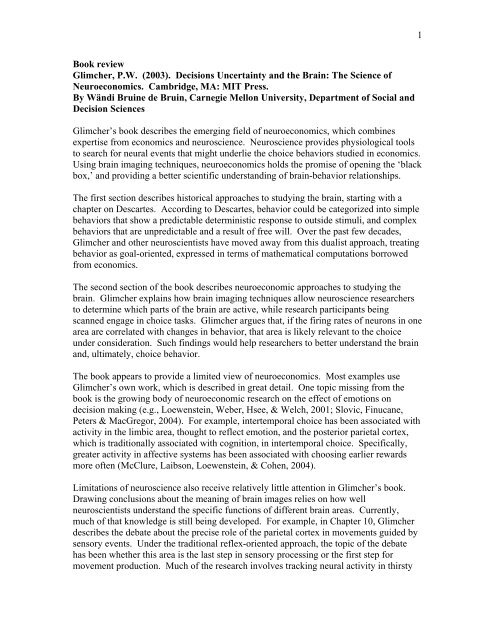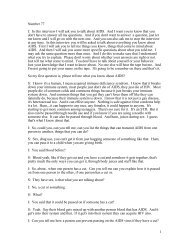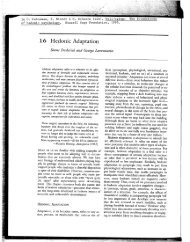1 Book review Glimcher, P.W. (2003). Decisions Uncertainty and the ...
1 Book review Glimcher, P.W. (2003). Decisions Uncertainty and the ...
1 Book review Glimcher, P.W. (2003). Decisions Uncertainty and the ...
Create successful ePaper yourself
Turn your PDF publications into a flip-book with our unique Google optimized e-Paper software.
<strong>Book</strong> <strong>review</strong><br />
<strong>Glimcher</strong>, P.W. (<strong>2003</strong>). <strong>Decisions</strong> <strong>Uncertainty</strong> <strong>and</strong> <strong>the</strong> Brain: The Science of<br />
Neuroeconomics. Cambridge, MA: MIT Press.<br />
By Wändi Bruine de Bruin, Carnegie Mellon University, Department of Social <strong>and</strong><br />
Decision Sciences<br />
<strong>Glimcher</strong>’s book describes <strong>the</strong> emerging field of neuroeconomics, which combines<br />
expertise from economics <strong>and</strong> neuroscience. Neuroscience provides physiological tools<br />
to search for neural events that might underlie <strong>the</strong> choice behaviors studied in economics.<br />
Using brain imaging techniques, neuroeconomics holds <strong>the</strong> promise of opening <strong>the</strong> ‘black<br />
box,’ <strong>and</strong> providing a better scientific underst<strong>and</strong>ing of brain-behavior relationships.<br />
The first section describes historical approaches to studying <strong>the</strong> brain, starting with a<br />
chapter on Descartes. According to Descartes, behavior could be categorized into simple<br />
behaviors that show a predictable deterministic response to outside stimuli, <strong>and</strong> complex<br />
behaviors that are unpredictable <strong>and</strong> a result of free will. Over <strong>the</strong> past few decades,<br />
<strong>Glimcher</strong> <strong>and</strong> o<strong>the</strong>r neuroscientists have moved away from this dualist approach, treating<br />
behavior as goal-oriented, expressed in terms of ma<strong>the</strong>matical computations borrowed<br />
from economics.<br />
The second section of <strong>the</strong> book describes neuroeconomic approaches to studying <strong>the</strong><br />
brain. <strong>Glimcher</strong> explains how brain imaging techniques allow neuroscience researchers<br />
to determine which parts of <strong>the</strong> brain are active, while research participants being<br />
scanned engage in choice tasks. <strong>Glimcher</strong> argues that, if <strong>the</strong> firing rates of neurons in one<br />
area are correlated with changes in behavior, that area is likely relevant to <strong>the</strong> choice<br />
under consideration. Such findings would help researchers to better underst<strong>and</strong> <strong>the</strong> brain<br />
<strong>and</strong>, ultimately, choice behavior.<br />
The book appears to provide a limited view of neuroeconomics. Most examples use<br />
<strong>Glimcher</strong>’s own work, which is described in great detail. One topic missing from <strong>the</strong><br />
book is <strong>the</strong> growing body of neuroeconomic research on <strong>the</strong> effect of emotions on<br />
decision making (e.g., Loewenstein, Weber, Hsee, & Welch, 2001; Slovic, Finucane,<br />
Peters & MacGregor, 2004). For example, intertemporal choice has been associated with<br />
activity in <strong>the</strong> limbic area, thought to reflect emotion, <strong>and</strong> <strong>the</strong> posterior parietal cortex,<br />
which is traditionally associated with cognition, in intertemporal choice. Specifically,<br />
greater activity in affective systems has been associated with choosing earlier rewards<br />
more often (McClure, Laibson, Loewenstein, & Cohen, 2004).<br />
Limitations of neuroscience also receive relatively little attention in <strong>Glimcher</strong>’s book.<br />
Drawing conclusions about <strong>the</strong> meaning of brain images relies on how well<br />
neuroscientists underst<strong>and</strong> <strong>the</strong> specific functions of different brain areas. Currently,<br />
much of that knowledge is still being developed. For example, in Chapter 10, <strong>Glimcher</strong><br />
describes <strong>the</strong> debate about <strong>the</strong> precise role of <strong>the</strong> parietal cortex in movements guided by<br />
sensory events. Under <strong>the</strong> traditional reflex-oriented approach, <strong>the</strong> topic of <strong>the</strong> debate<br />
has been whe<strong>the</strong>r this area is <strong>the</strong> last step in sensory processing or <strong>the</strong> first step for<br />
movement production. Much of <strong>the</strong> research involves tracking neural activity in thirsty<br />
1
monkeys, who are rewarded with fruit juice for shifting <strong>the</strong>ir eyes in a specific direction.<br />
Recent work by Platt <strong>and</strong> <strong>Glimcher</strong> (1999) suggests that <strong>the</strong> firing rate of neurons in<br />
monkeys’ lateral intraparietal cortex (LIP) is correlated with <strong>the</strong> anticipated juice reward<br />
for making a particular eye movement. Thus, <strong>the</strong> area may engage in sensorimotor<br />
processing relevant to choice behavior.<br />
Ano<strong>the</strong>r limitation is <strong>the</strong> correlational nature of neuroeconomic analyses. Additional<br />
evidence is needed to establish that an activated brain structure is essential for performing<br />
<strong>the</strong> task under study. Lesion studies help to determine whe<strong>the</strong>r areas are, in fact,<br />
necessary for carrying out specific functions. There have been cases in which structures<br />
activated in brain imaging studies failed to reveal impairments when lesioned (Adolphs,<br />
<strong>2003</strong>).<br />
Finally, an inherent limitation of brain imaging is that activity in itself does not show<br />
what is being processed. Several o<strong>the</strong>r approaches have been used to study decision<br />
processes, <strong>and</strong> are much less costly than brain imaging. They include think-aloud<br />
protocols (Ericsson & Simon, 1980), tracking eye movements (Russo & Rosen, 1974),<br />
computer tools tracing <strong>the</strong> information acquisition process (Payne, Bettman, & Johnson,<br />
1993), as well as <strong>the</strong> experimental methods used in behavioral economics (see Kahneman<br />
& Tversky, <strong>2003</strong>; Camerer, Loewenstein, & Rabin, <strong>2003</strong>). Although each method has its<br />
strengths <strong>and</strong> weaknesses, in combination with brain imaging, <strong>the</strong>y may provide broader<br />
insight into <strong>the</strong> function of different brain areas, <strong>and</strong>, eventually, how people are making<br />
decisions.<br />
As brain imaging techniques improve, <strong>and</strong> scientific underst<strong>and</strong>ing of <strong>the</strong> brain evolves,<br />
neuroeconomics will continue to inform our underst<strong>and</strong>ing of <strong>the</strong> link between <strong>the</strong> brain<br />
<strong>and</strong> behavior. Such insights may increase our underst<strong>and</strong>ing of how people make<br />
choices, <strong>and</strong> influence <strong>the</strong>ories of decision making. Ultimately, <strong>the</strong>y may improve<br />
economic models, <strong>and</strong> our ability to make economic predictions. As <strong>Glimcher</strong> explains,<br />
some exciting progress has already been made.<br />
References<br />
Adolphs, R. (<strong>2003</strong>). Investigating <strong>the</strong> cognitive neuroscience of social behavior.<br />
Neuropsychologia, 41, 119-126.<br />
Camerer, C.F., Loewenstein, G.F., & Rabin, M. (<strong>2003</strong>). Advances in Behavioral<br />
Economics. Princeton: Princeton University Press.<br />
Ericsson, K.A. & Simon, H.A. (1980). Verbal reports as data. Psychological Review, 87,<br />
215-251.<br />
Kahneman, D., & Tversky, A. (<strong>2003</strong>). Choices, values, <strong>and</strong> frames. New York:<br />
Cambridge University Press.<br />
Loewenstein, G.F., Weber, E.U., Hsee, C.K., & Welch, N. (2001). Risk as feelings.<br />
Psychological Bulletin, 127, 267-286.<br />
McClure, S.M., Laibson, D.I., Loewenstein, G.F., & Cohen, J.D. (2004). Separate neural<br />
systems value immediate <strong>and</strong> delayed monetary rewards. Science, 306, 503-507.<br />
Payne, J.W., Bettman, J.R., & Johnson, E.J. (1993). The adaptive decision maker. New<br />
York, NY: Cambridge University Press.<br />
2
Platt, M. L. & <strong>Glimcher</strong>, P.W. (1999). Neural correlates of decision variables in parietal<br />
cortex. Nature, 400, 233-238.<br />
Russo, J.E., & Rosen, L.D. (1974). An eye fixation analysis of multialternative choice.<br />
Memory <strong>and</strong> Cognition, 3, 267-276.<br />
Slovic, P., Finucane, M., Peters, E., & MacGregor, D. (2004). Risk as analysis <strong>and</strong> risk<br />
as feelings: Some thoughts about affect, reason, risk <strong>and</strong> rationality. Risk Analysis,<br />
24, 311-322.<br />
3







